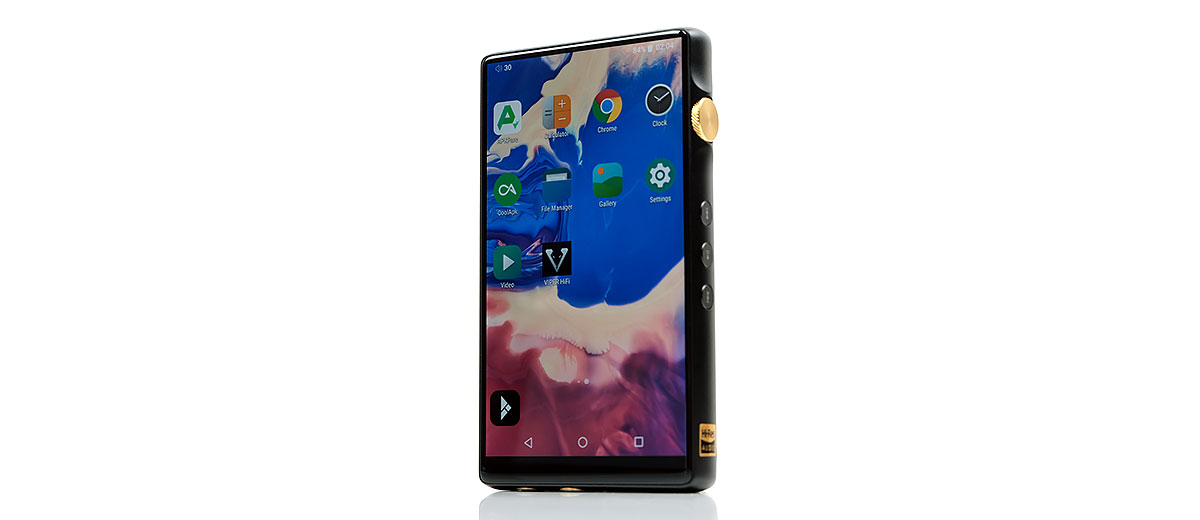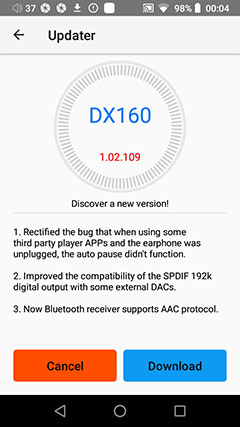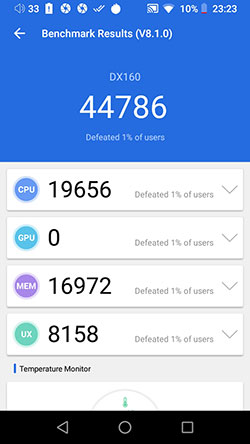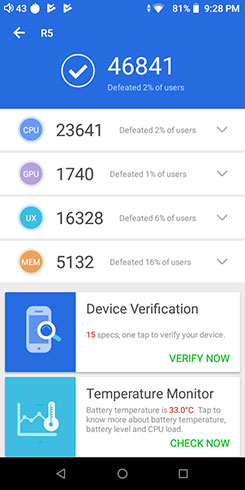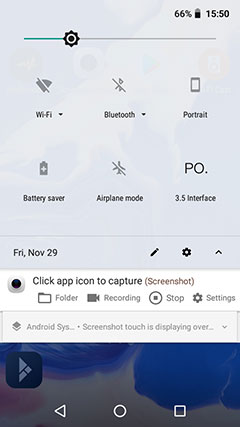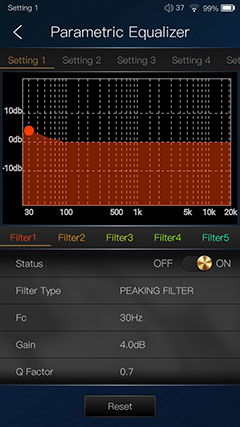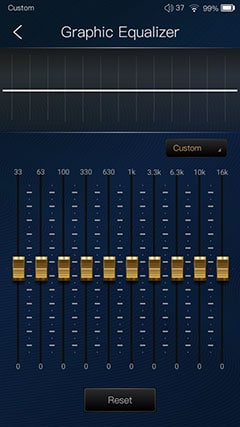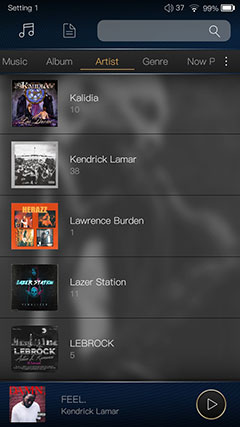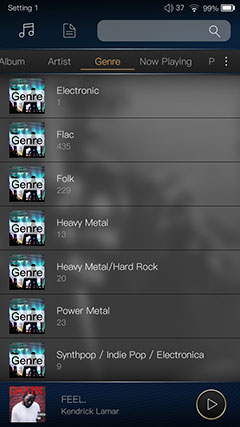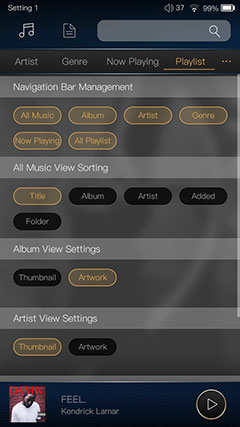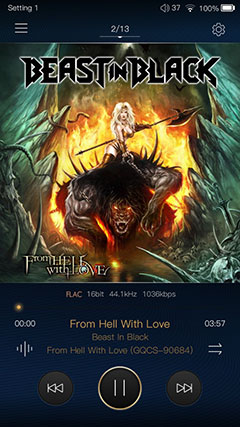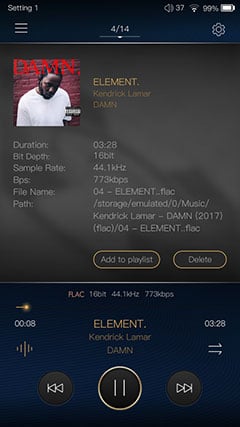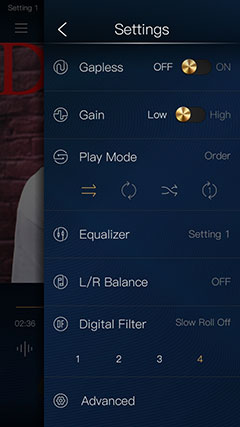Internal Hardware
DAC
For years iBasso have either used an AKM or Sabre chipset implementation. This time with the DX160 iBasso has gone with something quite different, a Dual Cirrus Logic CS43198 implementation. Now, this is actually a quite popular choice of chipsets right now with the HiBy R5 and AK’s SR15.
Decoding
That does mean, however, a slight drop in decoding capability from DSD512 native to DSD256, however, PCM decoding remains consistent at 32BIT/384kHz.
Codecs covered are wide-ranging and fairly complete. You will get everything from lossy MP3 up to FLAC, DSF, DFF, and DXD native decoding. the full list includes MQA, APE, FLAC, WAV, WMA, AAC, ALAC, AIFF, OGG, MP3, DFF, DSF, and DXD.
BitPerfect & MQA
The DX160 is capable of bit-perfect output up to 32BIT/384kHz and native MQA hardware decoding out of the box. This places it ahead of FiiO’s M11 and on par with the R5 which recently had a firmware update for MQA compatibility. The DX160 will support MQA in X4 mode as well as hardware support for streaming MQA via the TIDAL up to 72kHz.
Amplifier
Power
If iBasso has played it a bit safe with the chip choice for the DX160, it is really on the amplification side where they have pushed the boat out with some really excellent specs on paper. Despite not having a large interchangeable amp system, the DX160 is capable of some excellent output power with up to 3.2Vrms unbalanced and 6.4Vrms balanced via 3.5mm and 4.4mm analog outs.
Now I am always being asked if that is a loaded rating and I am always told by iBasso that it is maximum possible. However, published load testing is not always easy to compare with other manufacturers testing.
What we do know is that the Vrms correctly translates to 34mW unbalanced and 136mW balanced into a 300Ω load. However, their current buffer design means that the standard Vrms/32Ω extrapolation maths is not valid, otherwise, we are talking 1280mW into 32Ω loads balanced. iBasso has confirmed that the standard formula is not applicable here as there is not enough current output to generate that level of power.
Working on the 300Ω stated numbers we can, however, compare directly to the FiiO M11. The M11’s stated equivalent is 22mW unbalanced and 88.5mW balanced. That is quite a gap, meaning, the DX160 is much more powerful under heavier loads.
Performance Numbers
If the power output is right that makes the DX160 performance numbers in terms of THD+N the standout data for me when compared to its nearest competitors. Under a 32Ω load unbalanced you will get 0.0007% and an SNR of 125dB compared to 0.0014% and 120.5dB on the R5. For balanced 32Ω it is 0.00022% and 130dB on a 32Ω balanced compared to the R5’s SNR of 124dB.
The DX160 performance level also seems to be better than the DX220/AMP1 MKII performance which is balanced 125dB and a THD+N higher at 0.0002% (32Ω load, 3Vrms) balanced and 0.00035% (32Ω load, 1.8Vrms) unbalanced.
Do not get me started on the FiiO M11 specs which are way behind at 0.002% and 0.003% balanced and unbalanced into 32Ω loads and it shows in the level of hiss it delivers compared to the DX160 which has the blackest background in this class.
Software
Android
The DX160 comes with a completely open Android Oreo 8.1 platform out of the box, but like the FiiO M11, they do not ship internationally with Google Play Store installed. That has always been the case with iBasso Android implementations and a slight edge for HiBy OS implementations which do have it.
Instead, you get Cool APK and APK pure libraries which, to be honest, I value because they serve up a lot of apps that are otherwise region-locked for me like TIDAL. However, without Google Play you do lose a lot of app compatibility because of the requirements of Google Play Services as an integral part of the app’s performance.
The good news is that with the last firmware update on the DX160 you can now download Google Play as an APK via APK Pure and install it without any hiccups. That means it should work with apps that do need Play services to function like Hifi Cast.
The DX160 also has no Mango OS dual boot so it is pure Android Oreo 8.1 from the bootup. iBasso has provided Mango only as an app and it operates in the same manner as the app on the DX220 and DX150 minus a couple of features.
Performance Benchmarking
Hardware
Ok so just to fill you in quickly on some of the hardware behind the DX160 that does influence Oreo’s performance.
The first is the CPU. iBasso has chosen to go with the same Arm Cortex Octa-Core as you will find in the DX220 which is slightly behind the Snapdragon 425 inside the R5 though the results from AnTuTu are very positive. Neither DAPs are as lightning fast as the Samsung Exynos 7872 inside the M11, something which FiiO nailed at this price point or any price point for that matter.
The RAM has been pulled back from 4GB to 2GB which is similar to the R5 and 1GB less than the M11 so brownie points again to FiiO. However, the screen now is a shade smaller and you do have the option to switch to 720P which should be less of a drain on resources. That 1GB reduction is not that noticeable in our subjective testing unless you need huge buffering for hi-res streaming or planning on opening up a huge amount of apps at the same time.
AnTuTu Numbers
We also did our AnTuTu objective testing with a fresh install and minimal apps loaded. What we did note was that the latest firmware has the DX160 clock rate up to a faster 1200MHz which matches the DX220’s current clock rate but 200MHz slower than the R5 Snapdragon ceiling of 1400MHz.
We also loaded the DX160 with a few apps to represent a more normal operating setup such as TIDAL, Spotify and BubbleUPnP. WiFi and Bluetooth were turned off during testing and screen brightness at 100% and 1080p.
Rather than start with a comparison with other DAPs, I thought I would draw your attention to the difference in performance the screen resolution has on AnTuTu results. That seems fairly obvious. Drop the screen resolution and get better performance. If you are going for audio-only this is my recommendation, drop to 720P.
The screen resolution, when dropped to 720P, does also seem to give the DX160 a small boost in performance over the HiBy R5’s Antutu results. The FiiO M11 is still king in this category with a performance rated twice as high as pretty much any other DAP out there.
You will note that I got a score of 0% on the GPU. This may be an app incompatibility with the DX160 set up. I retried the test a few times since the initial first test but sadly that GPU score remained at zero.
Navigation
The DX160 navigates as you would expect using Oreo. That means using a drop-down menu combined with a deeper Android settings menu. There are also additional audio tweaking and navigation controls inside the main Mango App for media library management.
You do not have an apps drawer, instead, the iBasso theme will build additional screens to accommodate downloaded apps. I advise downloading the Nova Launcher if you really need an apps drawer.
Drop-Down Bar
The drop-down menu will give you access to key features such as WiFi, BT, battery saver, screen brightness control, 3.5mm output options, and the Android main settings menu. One nifty little addition to the drop-down bar is the display of the true sample rate that the DAC is working on.
Mango App Navigation
Within the Mango app, you have a further level of navigation similar to the DX220 experience. This includes media scanning, USB DAC, and a set of comprehensive audio controls such as their new PMEQ app, digital filters, channel balancing, replay gain and gapless. Note these are exclusive to the app only whereas the drop-down menu audio settings will apply to all media apps.
Features
If you have used the latest DX200/220 firmware then you will be quite familiar with the DX160 experience in terms of OS features. You get a healthy mix of Oreo Android core features such as OTA updates, battery usage tracking, audio controls at a macro level and that bit-perfect output across the platform.

Mango App
However, the starting point for most everyone will be their freshly redesigned Mango app experience which we first saw on the DX220.
The new player delivers a fairly seamless and click friendly UI compared to the older blocky version. It also allows you to tweak right everything right from the playback screen using a cogwheel icon top-right. This cogwheel, in turn, activates a quick drop-down menu with plenty of playback settings.
Of course, being so similar I still have the same issues as when I first tested it on the DX220, namely no cogwheel menu access outside of the playback screen which would be far more user-friendly. What is also noticeable comparing both apps on the DX220 and the DX160 is that not every single feature is on the lower tier DAP version.
The two key features missing are the triple gain switch on Mango DX220 and the number of digital filter choices you can pick on the fly. The DX160 Mango app is a dual low and high gain switch with no DX220 Mango app medium setting and the change of DAC from the ES9028Pro to the dual CS43198 implementation has cut down the filter choices.
For some, the fewer filter choices might mean something. I never really cared much about that, the main thing for me is that the brilliant PMEQ system from the DX220 is right there in all its glory in the DX160.
PMEQ
This PMEQ system places the DX160 on par with the likes of the mighty Lotoo PAW Gold Touch, as well as the DX220 for DSP options. Thank you very much indeed for including a seriously fun and interesting EQ system.
More than that it is pretty easy to use with complete access to 8 preset filter types, a touch directional F-Value point, gain control of between -20 and 20dB, and Q-Value control to narrow the bandwidth or focus on boosting instrumental elements such as a snare or kick drum attack from between 0.3 and 20.
I tend to find PMEQ particularly useful for monitors that are either overly dark or bright and I do not want to totally upset the balance but rather focus on one key area to bring out more presence such as percussion or low-end warmth. This can often render concerns about the stock presentation moot as it is more refined than your typical EQ system. There is no perceived volume loss either when turning it on which is a bonus.
Graphic EQ
The graphic 10-band EQ on the DX160 is exactly the same as the DX220 version and seems to operate in the same manner as the original EQ on the DX200 stock Mango app. You have 5 presets such as Classic, Pop, and Rock as well as the ability to create your own custom EQ profile and save it. It does have a new lick of blue paint compared to the tan and browns of the DX220 version.
The Mango 10-band EQ performance was just as good as the DX220 version. Testing it with the new Wavaya Octa custom 8 driver hybrid the change-up in the FR on the custom EQ profile was quite easily picked up on.
I tended to go for a little more low-end on most IEMs because of the neutral presentation of the DX160 but if you fancy more treble for darker monitors it is effective. For something more specific on the FR, I would revert back to the PMEQ system.
I must warn that you can easily distort the sound depending on the headphone or IEM you use. With the Octa, I found anything over 4-6dB below 100mHz started breaking up. This is not an overly subtle EQ tool but neither is it overblown or did it end up distorting everything on the IT04.
Like the DX220, you cannot turn both the Graphical EQ and PMEQ on at the same time on the DX160. You can only use one or the other.
Media Management
The media library on the Mango App is really good these days and works in much the same manner as the DX220 version. If you are coming from a FiiO and HiBy player you will find a lot of the UI and navigation of the files to be familiar which is a plus for me.
All the key tagging categories are on the top row and you simply slide to the right or left to bring up the relevant category without changing screens. If you are not happy with the selected categories and how to view your music iBasso have also provided you with a way to tweak the layout and categories in the Mango app.
Customization
The small 3 dot icon on the far right of the category menu slider will bring up a ton of navigation and view customization settings. You can tweak the tag categories, the all music sorting, album view settings and artist view settings. If you rather avoid tag views altogether the ‘creased page’ icon at the top right will allow you to navigate the internal storage manually.
I personally enjoy the Artwork view if I am not loading my library with too much stuff but once it gets long I revert to a list view which is called ‘Thumbnail’ here. Still, it is nice to have that choice.
The flat song tracks in the Genre category has improved on the DX160 version since I did the initial review of the DX220. You can now drill down to Genre – Album – Song but I still think it really should be Genre – Artist – Album – Song. Why miss that vital Artist grouping and go to the album? What if an Artist has many albums? It still feels incomplete to me.
Scanning & Accuracy
Scanning is by meta tags so the accuracy will largely depend on how well you have tagged your tracks. I had no issues on the speed taking mere seconds to quickly sort and file around 800 tracks. For the ones that I had tagged properly, they all showed up correctly in the library under each category.
iBasso has also done some media management fixes from my original DX220 review comments which have been very helpful. It seems that they fixed my initial complaint of the songs in albums being arbitrarily arranged in alphabetical order rather than any proper track running via the metatags. Pretty much every album looks 100% accurate in terms or the order of play.
They have also fixed the album grouping under the Artist category. All songs now seem to be under their correct album titles which makes browsing a lot easier. To be fair, the DX220 also has this improvement with a firmware update some time ago.
Playback
Aesthetics
The playback screen looks incredibly impressive with this Mango app design, enhanced cover art space, and that big borderless 5″ screen. All the playback tweaking and track information options are now much easier to access also. Not that there is a huge plethora of new playback features, in fact, they are more or less the same, just far better organized.
The ability to create playlists on the fly is also added which I had identified as missing in the original firmware review of the DX220. Simply press on the “pulse” icon to the far left near the bottom of the playback screen and look for the ‘add to playlist” option.
Options
The small pulse bar type icon also brings up the track data. That replaces one of the icons on the old Mango side tray that flipped out when you touched the cover art.
The original icon there from the older Mango brought a few options playback options such as the filters, gain and gapless playback that are all neatly housed in the cogwheel drop-down menu at the top of the playback screen.
Speaking of drop-down you can also pull down your current playlist in Mango OS by swiping from the top downwards.
Refining
Like the DX220 Mango app, the track timeline just below the track simple and bitrate data on the DX160 Mango playback screen is much more touch-sensitive to move forward or reverse. That was an awful implementation on the old Mango player.
Finally, you actually get the song title, artist and album information above the play button instead of having to touch the cover art to see what you are playing on the old Mango app.
Click On Page 3 below for Sound Impressions & Matchability

